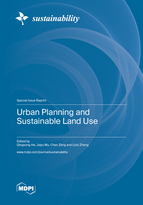Urban Planning and Sustainable Land Use
A special issue of Sustainability (ISSN 2071-1050). This special issue belongs to the section "Sustainable Urban and Rural Development".
Deadline for manuscript submissions: closed (5 January 2023) | Viewed by 24335
Special Issue Editors
Interests: land use change; spatial optimization; urban modeling; big data application
Special Issues, Collections and Topics in MDPI journals
Interests: urban landscape; green justice; big data
Special Issues, Collections and Topics in MDPI journals
Interests: land use and urban planning; regional governance; remote sensing and GIS
Special Issues, Collections and Topics in MDPI journals
Interests: urban economics; urban development
Special Issues, Collections and Topics in MDPI journals
Special Issue Information
Dear Colleagues,
We are now living in a world that is characterized by rapid urbanization, resulting in widely different patterns of land-use changes in different countries and regions. Highly diverse and intensive anthropogenic activities have thereupon aroused the reorganization of the urban landscape in the form of either sprawl or compact land use patterns. In either form, it has been common to see excessive and irrational land uses, which have carried significant burdens in natural resources and environment and caused various eco-environmental problems, such as farmland loss, habitat fragmentation, biodiversity reduction, the urban heat island effect, and climate change. Indeed, the multiscalar relevance and localized influences of rapid urbanization have long made it one of the most prominent issues regarding the sustainable development of our globe. Many urban planners, land-use researchers, and policy makers have devoted themselves to the understanding of spatial patterns in different contexts, their diverse driving forces, and their long-term effects on multi-aspects of a society. A commonly shared view among scholars is that it is of key imperativeness to pursue sustainable land development patterns that accommodate diverse requirements of urbanization while minimizing detrimental social and ecological impacts.
This Special Issue seeks to compile literature regarding contemporary urban planning and land use in different areas from a wide range of disciplines, with an ultimate aim of contributing to the global challenge of sustainable urban development. Original and innovative scholarly papers that address the simultaneous processes/spatial transformation of urban planning and land use are wanted, preferably for making use of state-of-the-art spatial technologies, such as remote sensing, GIS, big data, and social networks. Planning approaches and policy analyses are also welcomed since authorities and governance modes play a vital role in evolutions of urban planning and land uses in many countries or regions across the world.
Relevant topics include but are not limited to the following areas:
- Urban design and urban planning;
- Urban–rural land use and sustainable development;
- Application of Geo-informatics in urban planning and land use;
- Planning and public policy analysis in urban areas;
- Urban vibrancy and urban spatial pattern;
- Regional land use and development;
- Sustainable land use goals for SDGs;
- Sustainable urban land management approach;
- The theory or method of using urban big data to monitor urban development;
- Low-carbon oriented urban spatial structure optimization.
Dr. Qingsong He
Dr. Jiayu Wu
Prof. Dr. Chen Zeng
Dr. Linzi Zheng
Guest Editors
Manuscript Submission Information
Manuscripts should be submitted online at www.mdpi.com by registering and logging in to this website. Once you are registered, click here to go to the submission form. Manuscripts can be submitted until the deadline. All submissions that pass pre-check are peer-reviewed. Accepted papers will be published continuously in the journal (as soon as accepted) and will be listed together on the special issue website. Research articles, review articles as well as short communications are invited. For planned papers, a title and short abstract (about 100 words) can be sent to the Editorial Office for announcement on this website.
Submitted manuscripts should not have been published previously, nor be under consideration for publication elsewhere (except conference proceedings papers). All manuscripts are thoroughly refereed through a single-blind peer-review process. A guide for authors and other relevant information for submission of manuscripts is available on the Instructions for Authors page. Sustainability is an international peer-reviewed open access semimonthly journal published by MDPI.
Please visit the Instructions for Authors page before submitting a manuscript. The Article Processing Charge (APC) for publication in this open access journal is 2400 CHF (Swiss Francs). Submitted papers should be well formatted and use good English. Authors may use MDPI's English editing service prior to publication or during author revisions.
Keywords
- urban planning
- land use
- sustainable development
- public policy analysis
- urban vibrancy
- big data
- spatial optimization









